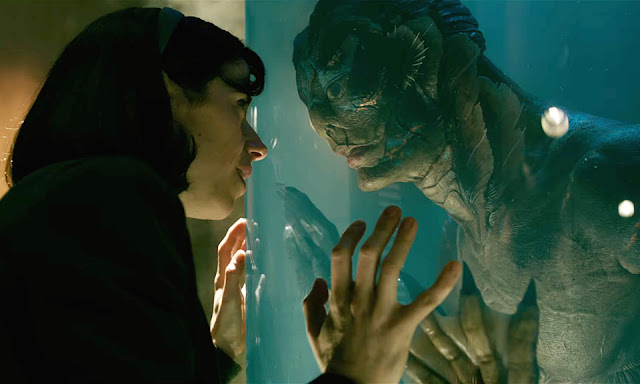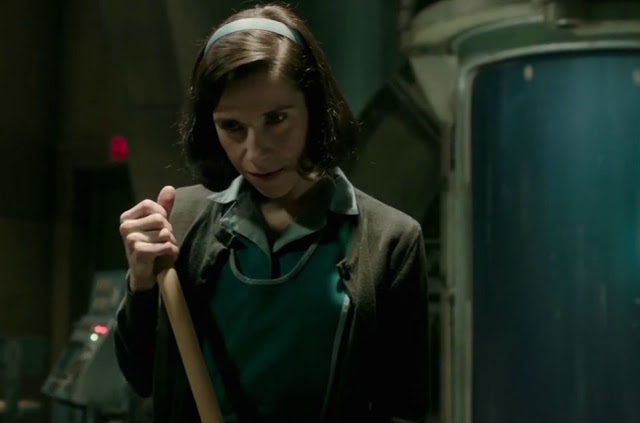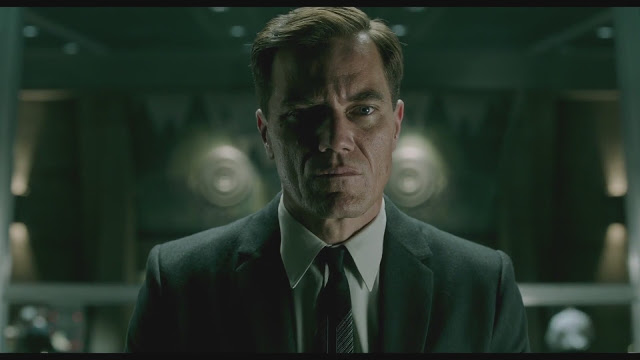It’s tempting to call The Shape of Water a monster movie, given that it revolves around the mysterious arrival of an amphibious fish-man—an imposing humanoid creature with slimy, mottled skin, webbed hands, and a nasty temper. And indeed, this inspired whatsit from Guillermo del Toro is replete with disturbing images and ghoulish presences: severed, decomposing fingers; a mutilated housecat; nefarious Russian communists; Michael Shannon’s sneer. Yet while The Shape of Water is suitably invigorating—as he demonstrated in Crimson Peak, del Toro knows how to set a mood and build suspense—it isn’t really a fright flick. It isn’t really any single type of movie, in fact, preferring to hopscotch across genres with dexterous fluidity. The result is a delicate, beguiling film that’s simultaneously familiar and original; you’ve seen the various pieces before, but you’ve never seen them assembled quite like this.
Some of them fit together better than others. A playful and enthusiastic remodeler of classic movies, del Toro takes evident delight in braiding together seemingly conflicting strains of stories; his last feature, the robot-kaiju mash-up Pacific Rim, was basically $190 million worth of giant toys crashing against one another, an appealing idea marred by uncharacteristically poor execution. The Shape of Water is a gentler, more thoughtful picture, but it still shows some seams from where its director has stitched its disparate elements together. As an underdog caper and a spy thriller, it’s entertaining without being especially exciting. But as a romantic fantasy, it largely soars.
We first meet our aforementioned amphibian-man—he’s never named, so let’s call him Amp—in a grim, grey research facility in 1960s Baltimore. It’s one of those dank underground government buildings with ribbons of metal piping and harsh fluorescent lighting, the kind where unsmiling men in white collared shirts bark out orders while the help keep their head down as they punch in and out. One such clocker is Elisa (a magnificent Sally Hawkins), a mute janitor with scars on her neck and a faraway glint in her eye. Elisa lives above a ramshackle movie theater, a superbly quaint touch that marks her as a dreamer and that also allows del Toro to indulge himself and smuggle in footage from some of his childhood favorites. She spends her evenings with her neighbor, the affable, slightly daft Giles (Richard Jenkins, typically excellent), watching episodes of Bonanza and practicing a charming tap-dance duet. Elisa, of course, never says a word, but as she silently gazes at the television, the yearning on her face makes plain that she longs for drama, excitement, and love.
She gets all that and more once she discovers Amp chained in one of the facility’s laboratories, where he’s restricted to swimming between a giant saltwater vat and a large cylindrical pod that will remind certain franchise fans of a bacta tank. Amp (Doug Jones, who played the faun in Pan’s Labyrinth; no, he isn’t also our newest senator) is currently being “studied” by some inquisitive and ill-mannered G-men, led by Strickland (Shannon, snarling every last word), a buttoned-up colonel who treats the marine life-form as a hostile “asset” to be tamed, taunted, and cattle-prodded. But rather than being scared of Amp, Elisa feels a kinship with him, and she begins sneaking off to the lab during her lunch break, feeding him hard-boiled eggs and regaling him with old music records.
You won’t believe what happens next, or maybe you will if you know that del Toro once pitched a reboot of The Creature of the Black Lagoon where the creature gets the girl. Through their shared non-verbal communication—Amp can’t speak either, so Elisa teaches him to sign—the two shunned misfits acquire a curiosity that shifts to attraction and then gradually blooms into a full-blown love affair. Well, maybe not so gradually; if anything, the burgeoning desire between Elisa and Amp feels a bit rushed, del Toro and co-writer Vanessa Taylor relying on a few sweet scenes in which Elisa impliedly discovers herself in her soulmate’s milky-blue eyes. It is not as though I needed a pop-soundtracked montage of the pair going to the movies and splitting a milkshake, but some further development of their mutual attraction—something beyond their generalized fascination with one another’s existence—might have made their subsequent romance land more forcefully.
Yet it still works, thanks in part to Amp’s expressiveness—Jones’s agile physicality is complemented by strong work from the FX and prosthetics teams—but mostly to Hawkins’ wonderful performance. She’s always been a deeply sympathetic presence, but here she makes Elisa a figure of thrilling complexity—sweet and big-hearted, yes, but also intelligent, angry, and lustful. That she does so without opening her mouth is a marvel, but Hawkins doesn’t overcompensate with stagy gestures, and Elisa’s silence eventually proves irrelevant. We don’t need to hear her speak to know what she’s feeling.
Next to her, everything else in The Shape of Water can’t help but feel somewhat one-dimensional. As Strickland, Shannon is deliciously repellent—whether he’s brusquely bedding his wife or buying a Cadillac, he evokes a square-jawed Norman Rockwell subject brought to diseased and sadistic life—but he ultimately comes off as caricatured evil. Meanwhile, the film spends far more time than it needs to with Dr. Hoffstetler (Michael Stuhlbarg), a Russian double agent who has his own mission regarding Amp and whose edgy run-ins with his Soviet comrades lack the required tension. And despite a warm and sad portrayal by Jenkins, Giles’ own troubles—he’s an advertising artist who’s being phased out in favor of professional photographers—feel tangential to the larger story.
But even if The Shape of Water is a bit scattered on a narrative level, it proves deceptively powerful and compassionate as a study of otherness. Its heroes—a disabled person, a gay man, a black woman (Octavia Spencer, playing Elisa’s loyal coworker), and an actual alien—collectively constitute society’s maligned and overlooked, and there’s pleasure in watching them collaborate to defy a system that so callously dehumanizes them. (Speaking of pleasure, the movie is also refreshingly frank about sex, from the way Elisa masturbates furiously in her bathtub every morning to the way del Toro stages her inaugural lovemaking session with Amp as a glorious aquatic mating ritual.)
Beyond that, The Shape of Water has a certain signature, a sense of identity, that allows it to transcend its plotty shortcomings. Sure, it’s expertly crafted—Alexandre Desplat’s score is rich and moving, and Dan Laustsen’s lustrous cinematography is gorgeous, especially in the underwater scenes—but rather than seeming like the discrete contributions of skilled artisans, that craftsmanship is harnessed in the service of a visionary with his own ideas about what filmmaking can be. Nowhere is that more evident than a late fantasy sequence in which Elisa, with Amp’s mystical assistance, suddenly imagines a different version of herself, a symphonic existence full of life and music and joy. In that instant, and indeed throughout The Shape of Water, del Toro does more than just convey his affection for old movies. Together, he and Hawkins remind us that even when it’s silent, cinema can truly sing.
Jeremy Beck is the editor-in-chief of MovieManifesto. He watches more movies and television than he probably should.




